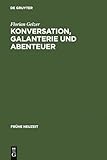Konversation, Galanterie und Abenteuer : Romaneskes Erzählen zwischen Thomasius und Wieland / Florian Gelzer.
Material type: TextSeries: Frühe Neuzeit : Studien und Dokumente zur deutschen Literatur und Kultur im europäischen Kontext ; 125Publisher: Tübingen : Max Niemeyer Verlag, [2011]Copyright date: ©2007Edition: Reprint 2011Description: 1 online resource (485 p.)Content type:
TextSeries: Frühe Neuzeit : Studien und Dokumente zur deutschen Literatur und Kultur im europäischen Kontext ; 125Publisher: Tübingen : Max Niemeyer Verlag, [2011]Copyright date: ©2007Edition: Reprint 2011Description: 1 online resource (485 p.)Content type: - 9783484366251
- 9783110937404
- 833
- PT759
- online - DeGruyter
- Issued also in print.
| Item type | Current library | Call number | URL | Status | Notes | Barcode | |
|---|---|---|---|---|---|---|---|
 eBook
eBook
|
Biblioteca "Angelicum" Pont. Univ. S.Tommaso d'Aquino Nuvola online | online - DeGruyter (Browse shelf(Opens below)) | Online access | Not for loan (Accesso limitato) | Accesso per gli utenti autorizzati / Access for authorized users | (dgr)9783110937404 |
Browsing Biblioteca "Angelicum" Pont. Univ. S.Tommaso d'Aquino shelves, Shelving location: Nuvola online Close shelf browser (Hides shelf browser)
Dissertation Universität Bern 2005.
Frontmatter -- Einleitung -- ERSTER TEIL: Grundlagen des ›galanten Diskurses‹ um 1700 -- 1. Der ›galante Diskurs‹ in Deutschland -- 2. Das Problem des galanten Stils. 2.1 Die Verschmelzung von Rhetorik- und Komplimentierdiskurs -- 2. Das Problem des galanten Stils. 2.2 ›Natürlichkeit‹ und ›wohlanständige Kürze‹ -- 2. Das Problem des galanten Stils. 2.3 Die Beherrschung des Komplimentierdiskurses als Thema des Romans -- 2. Das Problem des galanten Stils. 2.4 Konversation, Kompliment und Roman -- ZWEITER TEIL: Konzeptionen des romanesken Romans 1700-1750 -- 3. Das Romanverständnis auf der Grundlage von ›Stoff‹ oder ›Form‹ -- 4. Der Rekurs auf die Tradition: Erzählsubstrate und Kanonbildung. 4.1 Profilierung und Positionierung im internationalen Kontext -- 4. Der Rekurs auf die Tradition: Erzählsubstrate und Kanonbildung. 4.2 Traditionsbildung in den Romanvorreden -- 4. Der Rekurs auf die Tradition: Erzählsubstrate und Kanonbildung. 4.3 ›Galantes Erzählen‹ in Deutschland -- 4. Der Rekurs auf die Tradition: Erzählsubstrate und Kanonbildung. 4.4 Kontrastierungen und Amalgamierungen -- DRITTER TEIL: »Le Pays de la Romancie«: ›Galantes Erzählen‹ und Roman -- 5. Der Konflikt der Normen: Höfisches Ethos und naturrechtliche Selbstverantwortung -- 6. Normvermittlung und Funktionswandel: Transformationen ›galanten Erzählens‹ -- 7. »Die Quintessenz aller Abentheuer der Amadise«: romaneske Elemente bei C. M. Wieland -- Schluss -- Literaturverzeichnis -- Register
restricted access online access with authorization star
http://purl.org/coar/access_right/c_16ec
Around 1700 the notion of gallantry emanated from France as a stylistic and ethical model for Europe, with the novel acting as the principal school for gallant living. This comparative study is a contribution to a cultural history of gallantry. It gives a detailed account of the reception of ‘gallant discourse’ in German narrative prose, tracing it from its French sources (Scudéry) through authors such as Bohse and Hunold to its elaboration by Christoph Martin Wieland. Thus a picture is formed of “Romanesque narration” in the 18th century.
Um 1700 verbreitet sich von Frankreich aus das Ideal des Galanten als stilistisches und ethisches Leitmodell in Europa. Dabei dient vor allem der Roman als Schule eleganter Lebensart. Die komparatistische Studie versteht sich als Baustein zu einer Kulturgeschichte des Galanten. Ausführlich wird die Aufnahme des „galanten Diskurses” in der deutschen Erzählprosa nachgezeichnet: von den französischen Quellen (Scudéry) über Autoren wie Bohse und Hunold bis zu Weiterführungen bei Christoph Martin Wieland. So entsteht ein Gesamtbild des „romanesken Erzählens“ im 18. Jahrhundert.
Issued also in print.
Mode of access: Internet via World Wide Web.
In German.
Description based on online resource; title from PDF title page (publisher's Web site, viewed 28. Feb 2023)









